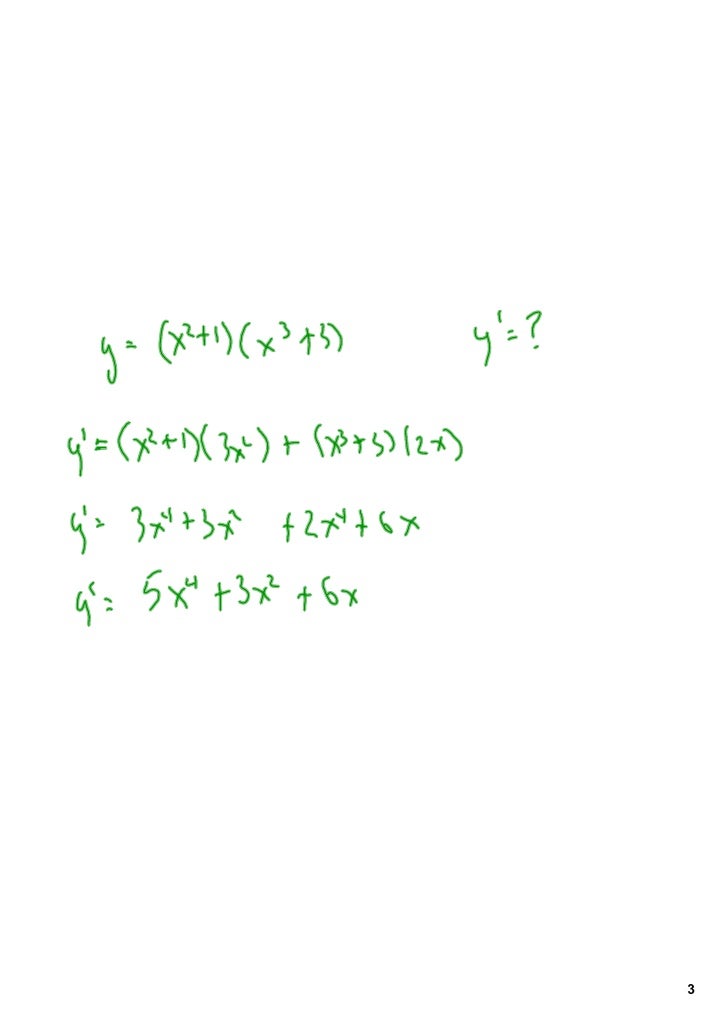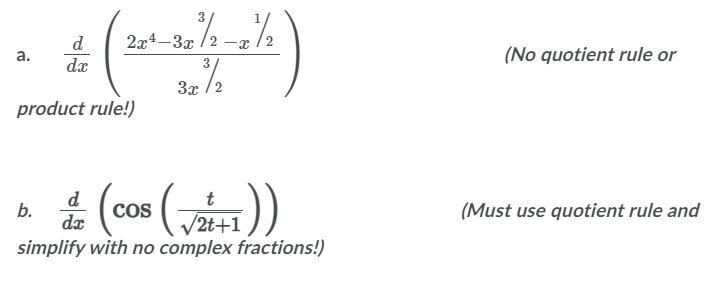- 3.2 Quotient Ruleap Calculus Algebra
- 3.2 Quotient Ruleap Calculus Calculator
- 3.2 Quotient Ruleap Calculus Equation
- 3.2 Quotient Ruleap Calculus Solver
What is the derivative of $ds (x^2+1)/(x^3-3x)$? More generally, we'dlike to have a formula to compute the derivative of $f(x)/g(x)$ if wealready know $f'(x)$ and $g'(x)$. Instead of attacking this problemhead-on, let's notice that we've already done part of the problem:$f(x)/g(x)= f(x)cdot(1/g(x))$, that is, this is 'really' a product,and we can compute the derivative if we know $f'(x)$ and$(1/g(x))'$. So really the only new bit of information we need is$(1/g(x))'$ in terms of $g'(x)$. As with the product rule, let's setthis up and see how far we can get:$$eqalign{{dover dx}{1over g(x)}&=lim_{Delta xto0} {{1over g(x+Delta x)}-{1over g(x)}overDelta x}cr&=lim_{Delta xto0} {{g(x)-g(x+Delta x)over g(x+Delta x)g(x)}overDelta x}cr&=lim_{Delta xto0} {g(x)-g(x+Delta x)over g(x+Delta x)g(x)Delta x}cr&=lim_{Delta xto0} -{g(x+Delta x)-g(x)over Delta x} {1over g(x+Delta x)g(x)}cr&=-{g'(x)over g(x)^2}cr}$$Now we can put this together with the product rule:$${dover dx}{f(x)over g(x)}=f(x){-g'(x)over g(x)^2}+f'(x){1over g(x)}={-f(x)g'(x)+f'(x)g(x)over g(x)^2}= {f'(x)g(x)-f(x)g'(x)over g(x)^2}.$$


- This chapter focuses on some of the major techniques needed to find the derivative: the product rule, the quotient rule, and the chain rule. By using these rules along with the power rule and some basic formulas (see Chapter 4), you can find the derivatives of most of the single-variable functions you encounter in calculus.
- F'(x) = (x – 3)(2)-(2x + 1)(1) / (x – 3) 2. Step 4:Use algebra to simplify where possible. The solution is 7/(x – 3) 2. How to Differentiate tan(x) The quotient rule can be used to differentiate tan(x), because of a basic quotient identity, taken from trigonometry: tan(x) = sin(x) / cos(x). Step 1: Name the top term f(x) and the bottom.

Calculus 120, section 3.1 Product Rule and Quotient Rule notes by Tim Pilachowski In chapter 2 we found one formula for finding a derivative: the power rule (specific and general versions. Everything else was extensions or applications of the same thing. Now we present two new rules for finding derivatives—these are ones you’ll need to.
Example 3.4.1 Compute the derivative of $ds (x^2+1)/(x^3-3x)$.$${dover dx}{x^2+1over x^3-3x}={2x(x^3-3x)-(x^2+1)(3x^2-3)over(x^3-3x)^2}= {-x^4-6x^2+3over (x^3-3x)^2}.$$
It is often possible to calculate derivatives in more than one way, aswe have already seen. Kut klose i like mp3 download. Since every quotient can be written as aproduct, it is always possible to use the product rule to compute thederivative, though it is not always simpler.
Example 3.4.2 Find the derivative of $ds sqrt{625-x^2}/sqrt{x}$ in two ways: using thequotient rule, and using the product rule.
3.2 Quotient Ruleap Calculus Algebra
Quotient rule:$${dover dx}{sqrt{625-x^2}oversqrt{x}} = {sqrt{x}(-x/sqrt{625-x^2})-sqrt{625-x^2}cdot 1/(2sqrt{x})overx}.$$Note that we have used $ds sqrt{x}=x^{1/2}$ to compute the derivative of$ds sqrt{x}$ by the power rule.
Product rule:$${dover dx}sqrt{625-x^2} x^{-1/2} = sqrt{625-x^2} {-1over 2}x^{-3/2}+{-xover sqrt{625-x^2}}x^{-1/2}.$$
With a bit of algebra, both of these simplify to$$-{x^2+625over 2sqrt{625-x^2}x^{3/2}}.$$
Occasionally you will need to compute the derivative of a quotientwith a constant numerator, like $ds 10/x^2$. Action winkel. Of course you can use thequotient rule, but it is usually not the easiest method. If we do useit here, we get $${dover dx}{10over x^2}={x^2cdot 0-10cdot 2xover x^4}={-20over x^3},$$since the derivative of 10 is 0. But it is simpler to do this:$${dover dx}{10over x^2}={dover dx}10x^{-2}=-20x^{-3}.$$Admittedly, $ds x^2$ is a particularly simple denominator, but we willsee that a similar calculation is usually possible. Another approachis to remember that$${dover dx}{1over g(x)}={-g'(x)over g(x)^2},$$but this requires extra memorization. Using this formula,$${dover dx}{10over x^2}=10{-2xover x^4}.$$Note that we first use linearity of the derivative to pull the 10 outin front.
Exercises 3.4
Find the derivatives of the functions in 1–4using the quotient rule.
Ex 3.4.1$ds {x^3over x^3-5x+10}$(answer)
Ex 3.4.2$ds {x^2+5x-3over x^5-6x^3+3x^2-7x+1}$(answer)
Ex 3.4.3$ds {sqrt{x}oversqrt{625-x^2}}$(answer)
3.2 Quotient Ruleap Calculus Calculator
Ex 3.4.4$ds {sqrt{625-x^2}over x^{20}}$(answer)
Ex 3.4.5Find an equation for the tangent line to $ds f(x) = (x^2 -4)/(5-x)$ at $x= 3$. (answer)
Ex 3.4.6Find an equation for the tangent line to $ds f(x) = (x-2)/(x^3 + 4x - 1)$ at $x=1$.(answer)
3.2 Quotient Ruleap Calculus Equation
Ex 3.4.7Let $P$ be a polynomial of degree $n$ and let $Q$ be apolynomial of degree $m$ (with $Q$ not the zero polynomial). Using sigma notation we can write$$P=sum _{k=0 } ^n a_k x^k,qquadQ=sum_{k=0}^m b_k x^k.$$Use sigma notation to write the derivative of the rational function$P/Q$.
3.2 Quotient Ruleap Calculus Solver

Ex 3.4.8The curve $ds y=1/(1+x^2)$ is an example of a class ofcurves each of which is called a witch ofAgnesi. Sketch the curve and find the tangent line to the curve at$x= 5$. (The word witch here is a mistranslation of theoriginal Italian, as described athttp://mathworld.wolfram.com/WitchofAgnesi.html andhttp://instructional1.calstatela.edu/sgray/Agnesi/WitchHistory/Historynamewitch.html.(answer)
Ex 3.4.9If $f'(4) = 5$, $g'(4) = 12$, $(fg)(4)= f(4)g(4)=2$, and $g(4) = 6$,compute $f(4)$ and $ds{dover dx}{fover g}$ at 4.(answer)
